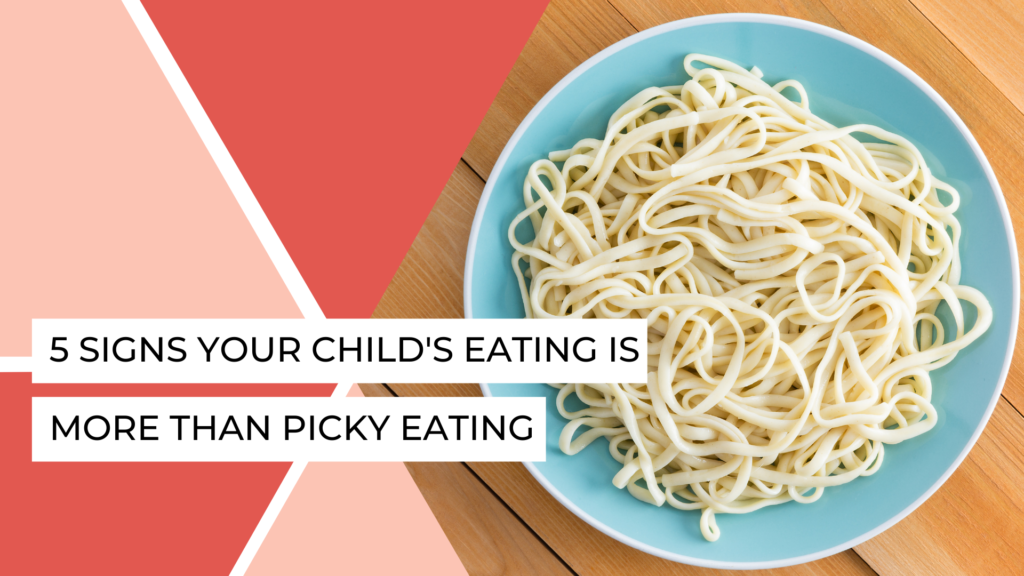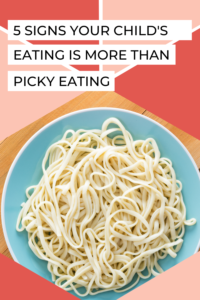This article discusses when your child’s eating habits might be more than picky eating.

Does this sound familiar? As a baby your child ate everything. They even loved salmon and broccoli! Then, suddenly, their palate became much more discerning and your child started to reject foods they used to like.
That’s when you started to worry.
As insanely frustrating as it is when your child suddenly refuses green vegetables or insists on dousing everything in ketchup, picky eating is considered a normal and temporary part of child development.
But in some cases, it’s not normal and it’s not temporary.
It is common for toddlers to start to prefer bland foods, to reject foods they used to like, or to be hesitant to try new foods.
But what happens when you notice these habits happening to an extreme?
Your doctor has brushed it off as normal, but your child’s “pickiness” seems to be different from their friends’ and you begin to worry about picky eating.
Here are 5 signs that your child’s eating could be more than picky eating
Your child eats a limited number of foods
A common first sign of picky eating is food rejection. A child’s palate becomes more discerning or they start to demonstrate their autonomy by saying no. It is not expected that a child will accept and enjoy every food that is presented to them. But children should still feel comfortable eating an array of different foods.
A child only eating a handful of foods could be a sign of something more than picky eating.
Rejects entire food groups
It is not typical for a child to avoid eating entire food groups (not eating ANY vegetables or ANY proteins, for example). Many times children may prefer particular fruits or might request a certain shape of pasta seven days a week. But a child who can only eat these foods and does not enjoy foods from every food group might be more than a picky eater.
Fear or anxiety around eating new foods
Hesitation or refusal to try new foods is common in toddlers and is a hallmark sign of typical picky eating. Anxiety or fear is a different story. If your child has not tried a new food in a while or becomes upset about the prospect of trying a new food, it might be more than picky eating. Another sign of something more than picky eating is when a child prefers to eat alone or gets worried about eating in an unfamiliar environment like at a restaurant or birthday party.
Restricts foods based on texture, look, and/or other qualities
We all have our preferences – that’s okay and completely normal. Yet limiting foods to only those that have a certain texture, look, or flavor (for example, only eating soft neutral color foods like pancakes, bananas, and yogurt) is not typical and could indicate sensory processing difficulties or difficulties with oral-motor skills associated with something more than picky eating.
Rigid preferences about brand, preparation, etc
A food preference is one thing. A requirement is another. A sign of something more than picky eating is when a child doesn’t eat a food in general but only eats a particular variety. For example, many picky eaters might love macaroni and cheese. A more extreme picky eater may only eat a particular brand, shape, and flavor of macaroni cheese. Similarly, signs of something more than typical picky eating include rigidity with the type of plate they use, the time of day they eat the food, or who prepares the food.
None of these signs are a guarantee that what your child is going through isn’t just a phase. If you are concerned, it’s always a good idea to bring up any concerns with your pediatrician or start working on steps to help extremely picky eaters feel more comfortable trying new foods.
What to do if you think you’re dealing with more than picky eating
- Don’t blame yourself. Extreme picky eating is not a parent’s fault. Instead of feeling guilty, choose to get the help your child needs.
- Get help. If you are worried, if mealtimes are stressful, if your child’s eating seems to be getting worse, or if they are losing weight get help, let’s chat. I work with parents of extremely picky eaters to help their children learn to comfortably and confidently try new foods.




My child has sensory
thanks for sharing Amber 🙂